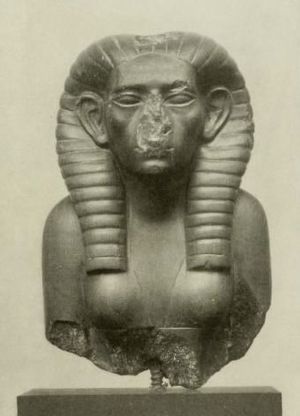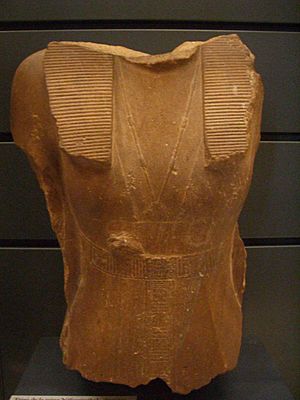Sobekneferu facts for kids
Quick facts for kids Sobekneferu |
|
|---|---|
| Neferusobek Scemiophris from Greek: Σκεμίοφρις |
|

Statue of Sobekneferu
|
|
| Pharaoh | |
| Reign | 3 years, 10 months, and 24 days according to the Turin Canon in the mid 18th century BC. (Twelfth Dynasty) |
| Predecessor | Amenemhat IV |
| Successor | Sobekhotep I or Wegaf |
| Consort | Amenemhat IV? |
| Father | Amenemhat III |
| Burial | Northern Mazghuna pyramid? |
Sobekneferu, also known as Neferusobek, was a powerful queen who became a pharaoh in ancient Egypt. Her name, Sobekneferu, means 'Beauty of Sobek'. Sobek was an important crocodile god in Egyptian beliefs. She was the last ruler of the Twelfth Dynasty during the Middle Kingdom. Sobekneferu became pharaoh after Amenemhat IV died. She might have been his sister or his wife. Her rule lasted for about three years and ten months.
Contents
Sobekneferu's Family
Sobekneferu was the daughter of Pharaoh Amenemhat III. We do not know anything about her mother.
The connection between Sobekneferu and Amenemhat IV is not fully clear. Some historians think they were brother and sister. Others believe they were married. Sobekneferu became pharaoh after Amenemhat IV passed away. This might have happened because he had no male children to take the throne.
Her Time as Pharaoh
By the time Sobekneferu became pharaoh, the Middle Kingdom was starting to weaken. She ruled for about four years. Not many records from her time have survived. Her death marked the end of the Twelfth Dynasty. It also started a period called the Second Intermediate Period. This period lasted for about 200 years.
After Sobekneferu, either Sobekhotep I or Wegaf became pharaoh. They started the Thirteenth Dynasty.
What We Know About Her Rule

We have only a few items that show Sobekneferu was pharaoh. The British Museum has a special cylinder seal with her name on it. This seal is made of glazed stone called steatite. It is about 4.42 centimeters (1.74 inches) long.
Historians have found a few statues of Sobekneferu. Most of these statues are missing their heads. One statue shows her wearing both male and female clothing. It has an inscription that says 'daughter of Re, of his body, Sobekneferu'. Another statue shows her stepping on the Nine Bows. This symbolized her power over Egypt's enemies. One statue with her head was in the Egyptian Museum of Berlin. Sadly, it was lost during World War II.
Sobekneferu also had buildings constructed. She added to the Pyramid of Amenemhat III in Hawara. She left inscriptions on granite columns at a temple in Kom el-Akârib. Her building projects often linked her to Amenemhat III. This suggests she was his royal daughter. She might have been Amenemhat IV's stepsister. During her reign, Sobekneferu used the title 'King's Daughter'. This supports the idea that she was Amenemhat III's daughter.
Where She Might Be Buried
Sobekneferu's tomb has not been found for sure. Some people think the Northern Mazghuna pyramid might be her burial place. However, there is no strong proof to confirm this. The pyramid might have been built much later than her time.
See also
 In Spanish: Neferusobek para niños
In Spanish: Neferusobek para niños
- Hatshepsut
- Merneith
- Neithhotep
- Statue of Sobekneferu



